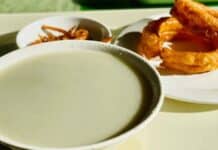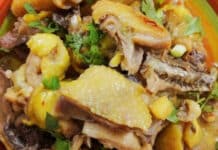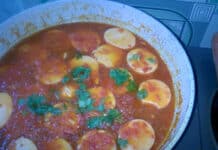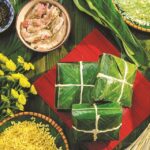Preserves are an indispensable delicacy during the traditional Lunar New Year of the Vietnamese. Despite the passing of time, the sweetness of the Tet preserves remains deeply ingrained in the minds of every Vietnamese person as a refined gift passed down from our ancestors.
So, what are preserves? Preserves are a type of confectionery made by cooking various fruits and some tubers with sugar to a dryness of 65% – 70%. Sugar is an essential ingredient in preserves and should reach a concentration of about 55% – 60%. Sugar not only sweetens but also acts as a preservative and thickening agent.
The fruits and tubers used to make preserves are very diverse and plentiful, ranging from strawberries, coconut, sweet potatoes, apples to lotus seeds. Each type of preserve will have its own unique color and flavor depending on the ingredients used. Fruit preserves are prepared in many forms, which can be categorized as solid preserves, soft preserves, chunk preserves, glazed preserves, and dry preserves.

In the past, every Lunar New Year, families would gather together, huddling around the fire, and make preserves to prepare for the first days of the new year, offering each other these sweet treats as a way of wishing the best for the coming year.
2. How to Make Traditional Tet Preserves at Home
2.1. How to Make Tomato Preserves
When it comes to tomatoes, you probably think of the red fruit rich in vitamin A, good for the eyes and skin… Not to mention their sweet taste and pleasant aroma that always make daily family meals more appealing. So, it’s no surprise that tomato preserves are often chosen to be part of the Tet candy tray.
The red color of tomatoes also brings a sense of warmth during the chilly early spring days and is considered a symbol of good luck. To make a delicious and nutritious batch of tomato preserves, you can use either large tomatoes or, for convenience, opt for smaller cherry tomatoes.
Ingredients:
- Cherry tomatoes: 1kg
- White granulated sugar: 400gr
- Lime: 30gr
Instructions:
- Step 1: Mix lime with about 2 liters of water and stir well. Let the lime water settle, then skim off the clear limewater from the top. Next, choose ripe, red cherry tomatoes that are not bruised or damaged, and wash them thoroughly. Use a sharp object to prick small holes in the tomatoes. Soak the tomatoes in the limewater for about 10 hours or overnight.
- Step 2: After soaking the tomatoes overnight, rinse them several times with cold water to remove the lime flavor. Drain the tomatoes in a colander.
Once the tomatoes are dry, marinate them with sugar until the sugar completely dissolves. (The sweetness can be adjusted according to personal preference and doesn’t have to follow the exact recipe.) - Step 3: Place the tomatoes and the tomato-infused syrup in a thick-bottomed pot. Bring to a boil, then reduce the heat to the lowest setting so that the tomato preserves only simmer gently. Occasionally shake the pot to allow the syrup to coat the tomatoes evenly.
- Step 4: When the syrup has reduced and the cherry tomatoes have turned into preserves with a chewy texture and a glossy red appearance, turn off the heat. If you prefer drier preserves, you can place the entire batch in an oven and dehydrate at 100 degrees C for 5-10 minutes.
- Step 5: Store the preserves in airtight glass jars or plastic bags. For extended shelf life, store in the refrigerator.

2.2. How to Make Marmalade
Ingredients:
- 1kg ripe quats
- 800gr of golden or white granulated sugar
- 1 teaspoon of lime powder
- Salt
- Water
Instructions:
- Select ripe, golden quats for a more attractive color. Wash the quats, then soak them in a dilute salt solution for 30 minutes. Rinse and drain.
- Mix lime powder with 1.5 liters of water in a container and stir well. Allow the lime to settle.
- Using a sharp knife, make four longitudinal cuts on each quat, creating small, even slits. Press the quats flat to remove the seeds and reduce the amount of juice.
- Place the quats in a clean container, then pour in the clear limewater and soak for about 6 hours. Afterward, rinse and drain.
- Transfer the quats to a clean container, add sugar, and mix well. Let the quats marinate until the sugar dissolves completely before cooking.
- Pour the quats and syrup into a pan and cook over medium heat until the mixture comes to a boil. Continue cooking for another 5-7 minutes, then reduce the heat to low and let the quats simmer gently, occasionally stirring, until the syrup thickens and the quats turn translucent. Turn off the heat.
- Arrange the quats on a baking tray or rack and place them in an oven at 100 degrees C. Dehydrate for about 40-50 minutes, or alternatively, sun-dry them until the desired level of dryness is achieved.
Store the marmalade in clean glass jars with tight-fitting lids and keep in a cool, dry place.

2.3. How to Make Winter Melon or Ash Gourd Preserves
Winter melon or ash gourd preserves are delicious, crispy, and visually appealing. They are also easy to make, so let’s explore the process together.
Ingredients:
- 2 mature winter melons or ash gourds (about 10kg)
- 8 liters of limewater
- 25 grams of alum
- A few drops of pomelo essence
- Green food coloring
- 4 to 5kg of white granulated sugar.
Instructions:
- Step 1: Peel the winter melons or ash gourds, remove the seeds and fibrous core, and cut the flesh into bite-sized pieces. You can also cut the melon/gourd into long strips about 5-7cm in length, creating a decorative pattern with a serrated knife. Soak the melon/gourd pieces in limewater for about 8 hours or overnight. (Note: The limewater should completely cover the melon/gourd pieces, as it helps give the preserves a crispy texture.)
- Step 2: After soaking, remove the melon/gourd pieces from the limewater and rinse them several times with water. Spread the pieces out on a rack to drain and air-dry completely. Next, dissolve the alum in 3 liters of water and bring it to a boil in a pot. After the solution boils, add the melon/gourd pieces and blanch for about 1-2 minutes to make them translucent. Then, drain the pieces and immediately rinse them with cold water.
Let the pieces air-dry in a well-ventilated area for about 2-3 hours. - Step 3: Marinate the melon/gourd pieces with sugar at a ratio of 1kg of melon/gourd to 750 grams of sugar for about 4 hours until the sugar completely dissolves. Occasionally stir or toss the mixture to ensure even coating. After the melon/gourd pieces have absorbed the sugar, divide them into two portions. Place one portion into a wide, deep pan to dry out the excess moisture. Cook the other portion separately to make green-colored preserves. Simmer over low heat until the syrup reduces and starts to caramelize, stirring occasionally to prevent the sugar from clumping. When the syrup becomes sticky and coats the melon/gourd pieces, add the pomelo essence and stir well.
- Step 4: To make the green-colored preserves, add a few drops of green food coloring to the remaining melon/gourd pieces and cook them as described in Step 3.
We wish you success in making these delicious and simple winter melon or ash gourd preserves!


2.4. How to Make Young Coconut Preserves
Ingredients:
- 1kg young coconut
- 400-450gr of sugar
- 1 teaspoon of turmeric powder for yellow color
- 1 teaspoon of strawberry powder for pink color
Instructions:
- Choose young coconuts that are neither too soft nor too hard. You can test their ripeness by pressing them with your fingernail; they should feel slightly soft. Separate the coconut flesh from the hard shell and peel off the outer brown layer. Cut the coconut flesh into matchstick-sized pieces.
- Place the coconut pieces in a bowl of warm water and rinse several times to remove the coconut oil. Continue rinsing until the water runs clear. This step ensures that the coconut pieces will better absorb the sugar and dry out faster during cooking, resulting in preserves with a longer shelf life. After rinsing, drain the coconut pieces well.
- Bring a pot of water to a boil and blanch the coconut pieces for about 1-2 minutes. Drain and set aside.
- Divide the coconut pieces into two bowls, then add sugar, turmeric powder, and strawberry powder to each bowl. Toss to coat the coconut pieces evenly. During the marination process, occasionally stir the mixture to ensure even coating. You can also create different colors using natural fruit juices of your choice, marinating the coconut pieces with these juices along with the sugar.
- After the coconut pieces have absorbed the sugar, transfer either the pink or yellow batch to a pan and pour in the syrup. Cook over medium heat until the syrup comes to a boil, then reduce the heat to low. Occasionally stir the mixture to prevent it from burning.
- Continue cooking until the syrup reduces and starts to caramelize, then reduce the heat to the lowest setting and keep stirring until the sugar crystallizes and coats the coconut pieces. Turn off the heat and continue stirring for a few more minutes to ensure the preserves are completely dry. Otherwise, they may release moisture later.
- Repeat Step 5 for the remaining color batches. Once all the preserves are cooked, let them cool completely before packaging or storing in airtight containers.

2.5. How to Make Ginger Preserves
The Lunar New Year is a time when everything is renewed and vibrant. To match this atmosphere, let’s make ginger preserves, characterized by their warm yellow color and a flavor that is both sweet and pungent. Ginger preserves are not only delicious but also have health benefits, soothing sore throats and warming the body during the cold season.
Ingredients:
- Fresh ginger: 1kg
- White granulated sugar: 500 grams
- Fresh lemon: 1 fruit
- Vanilla extract: 1 tube
Instructions:
- Step 1: Wash the ginger, drain, and peel off the skin, removing any small knobs. After peeling, immediately soak the ginger in cold water to prevent discoloration. You can cut the ginger into thin strips or slices, depending on your preference. Thinner slices will result in more delicious preserves.
- Step 2: Remove the ginger from the water and drain well. Place the ginger in a pot, add water to cover, and bring to a boil. Drain the water and repeat the boiling process two to three more times to reduce the pungency of the ginger. In the final boiling step, add the juice of one lemon or rice vinegar to give the ginger a gentle yellow color.
- Step 3: Drain the ginger and let it dry completely. Next, marinate the ginger with white granulated sugar. You can layer the ginger and sugar in a pot or bowl, alternating layers of ginger and thin layers of sugar, until all the ginger and sugar are used up. If you are making a smaller batch, you can simply mix the ginger and sugar together in a pot. Let the ginger marinate for about 6-7 hours or until the sugar completely dissolves. During this waiting period, occasionally stir the mixture to ensure even coating.
- Step 4: Cook the ginger and sugar over medium heat, not too high. Stir occasionally to prevent burning. When the syrup starts to thicken and boil, reduce the heat to low and begin simmering the ginger. Use chopsticks to stir the mixture from the sides of the pot toward the center. Stir gently to avoid breaking the ginger pieces. Continue simmering until the syrup dries out and crystallizes, coating the ginger pieces with white sugar. At this point, the ginger pieces will be dry and have a pleasant aroma.
- Step 5. When the ginger pieces start to separate and are coated with sugar, turn off the heat and continue stirring for another 2-3 minutes. Add vanilla extract for enhanced flavor, then remove the pot from the heat and let it cool. Transfer the ginger preserves to airtight glass jars or plastic bags.
With just one day of preparation, you’ll have delicious ginger preserves that are both sweet and pungent. Enjoy them with a cup of tea and your favorite book. Ginger preserves are also an effective remedy for coughs.
2.6. How to Make Watermelon Rind Preserves
The distinctive red color of watermelon represents good luck, while the white flesh is crisp and refreshing, and the green rind adds a chewy texture.
- 1 kg watermelon
- Limewater
- 1 tablespoon of alum
- 500 gr of sugar
- Vanilla extract
- Choose watermelons with thick rinds and slightly underripe (unlike what you would look for when buying watermelons to eat fresh).
- Wash the watermelon, then cut it into pieces of your desired size or thin strips.
- Soak the watermelon pieces in limewater for a full day and night to firm them up. Rinse gently several times to remove the lime flavor.
- Dissolve 1 tablespoon of alum in 2 liters of boiling water. Blanch the watermelon pieces for about 30 seconds.
- Rinse the watermelon pieces several times until you can no longer taste the sourness of the alum.
- Spread the watermelon pieces on a rack and sun-dry them for about 4 hours or air-dry until they become slightly shriveled. This step helps remove excess moisture from the watermelon, making it easier for the sugar to crystallize during cooking.
- Marinate 500 grams of sugar with 1 kg of watermelon for about 30 minutes or until the sugar dissolves.
- Strain the syrup into a pan and cook the watermelon pieces over medium heat to release their moisture. Then, discard this initial batch of syrup.
- Add the reserved syrup to the pan and simmer over very low heat until the sugar crystallizes. Add vanilla extract and continue cooking until the preserves are completely dry.
Will Heavy Rains Lash Northern Regions Again After a Sunny Spell?
Today’s weather forecast predicts sunny skies across the northern regions of Vietnam, including the Northwest and Northeast regions, as well as the North Central Coast. The sunny weather is expected to persist throughout the day. From September 9th to 13th, however, scattered showers and thunderstorms are likely, with localized heavy rainfall in some areas.




































